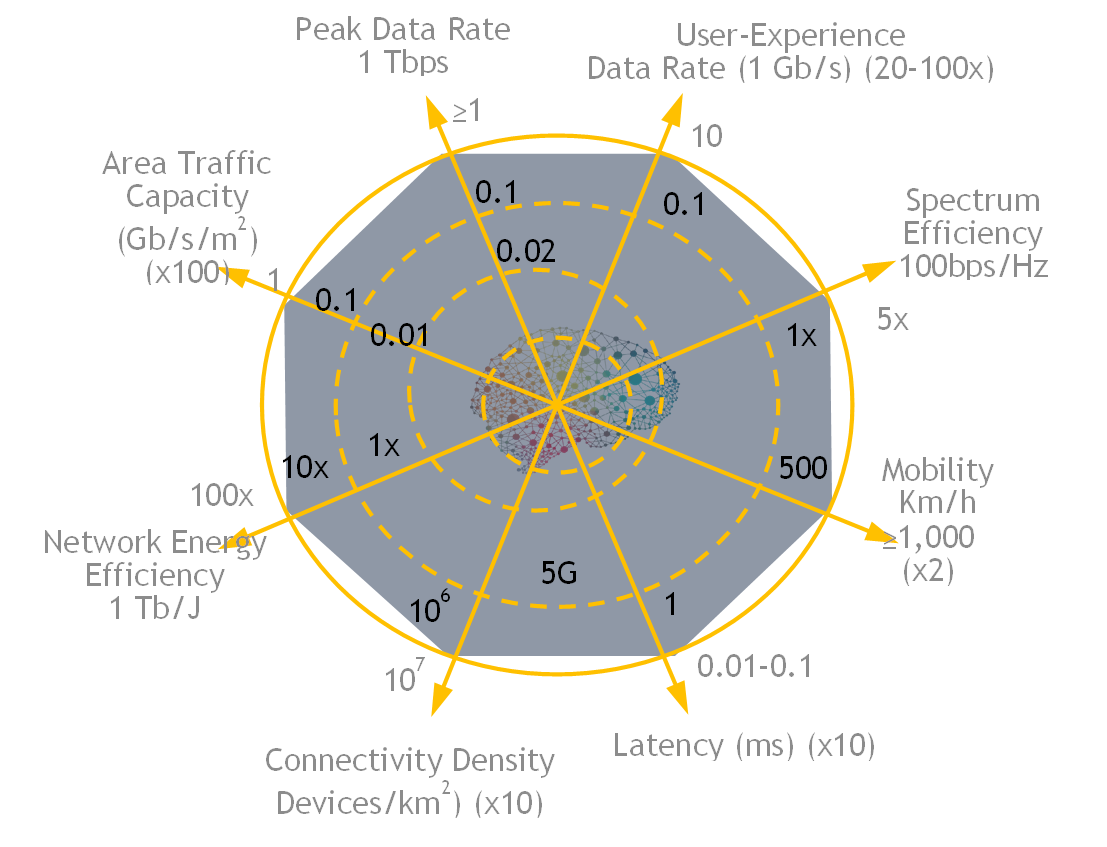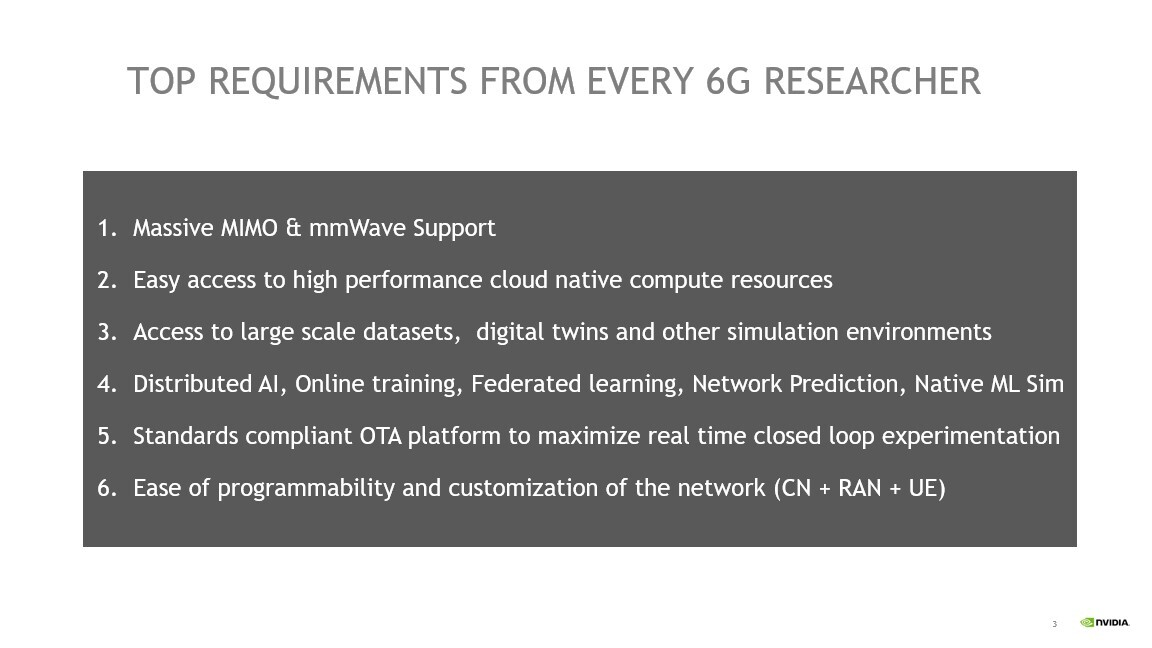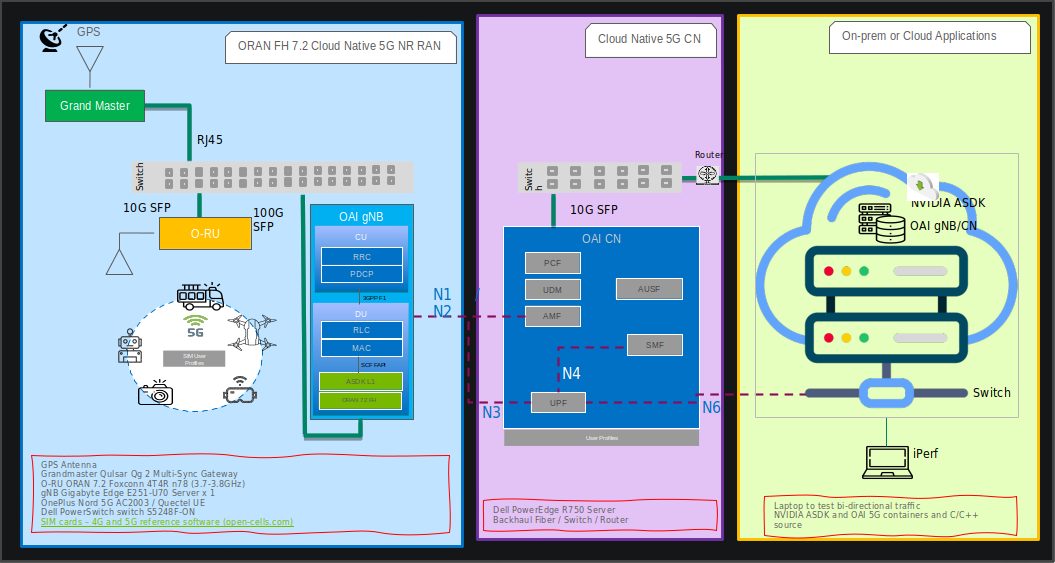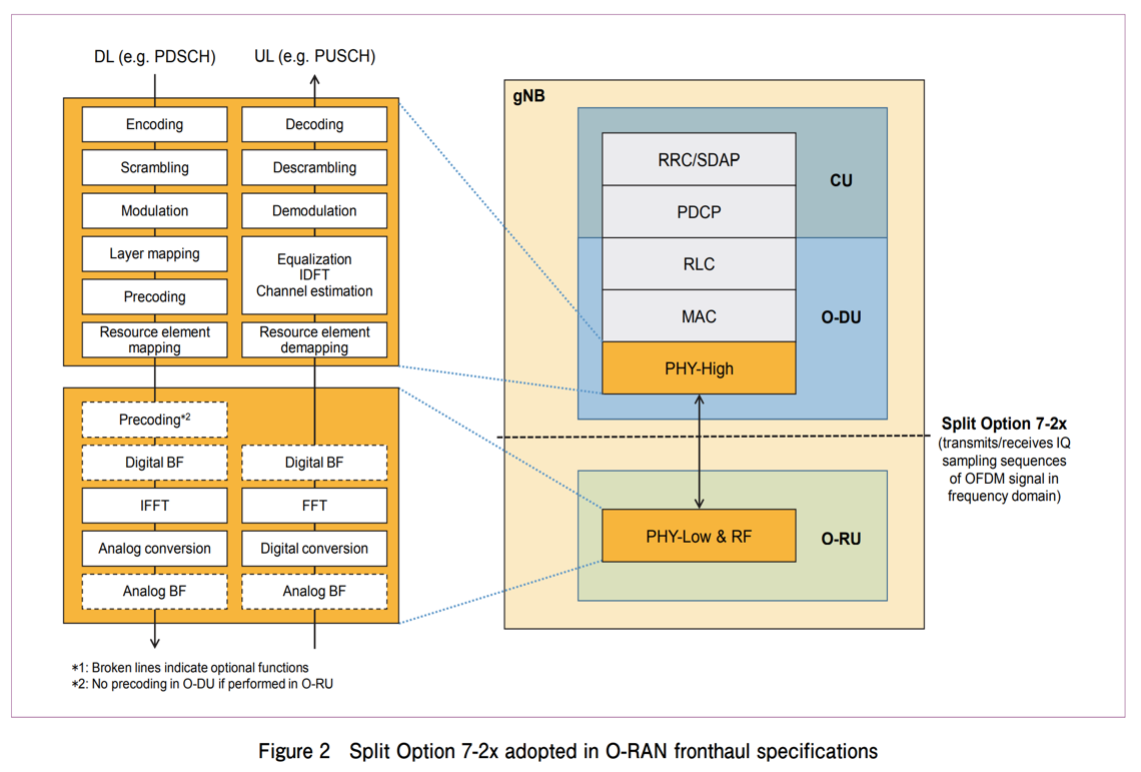Product Brief
With the deployment of 5G systems in full swing, the research focus on 6G wireless communications systems has begun. Keeping up with the tradition of a new generation of cellular systems once every ten years, there is an expectation that 6G systems will be standardized with deployments starting around 2030[https://www.itu.int/en/ITU-T/focusgroups/net2030/Documents/White_Paper.pdf]. Since it typically takes ten years for a NG wireless technology to see commercial daylight, the time to begin research for 6G is now.
It is crucial to ensure ease and availability of a research and innovation platform to develop technologies for future communications. While it is possible that some of the requirements can already be met by incorporating new advancements within the advanced 5G framework, as evolution to 6G there are some requirements that are a fundamental shift and will introduce significant changes in underlying technology.
Besides enhanced mobile broadband for consumers with very high data rates of 1Tbps, 5G+ is widely expected to enable the Fourth Industrial Revolution through the digitalization and connectivity of all things (humans, machines, sensors). Digital twins of objects created in edge clouds will form the essential foundation of the future digital world. The realization of a comprehensive and true digital world of the physical world at every spatial and time instant will be required at extreme low latency. Sensors will accurately map every instant and integrate into the digital and virtual worlds, to enable new Artificial Intelligence(AI) enabled capabilities. augmented reality user interfaces will enable efficient and intuitive human control of all these worlds, whether physical, or virtual. Simply put, 6G is widely expected to be smarter, faster, and more efficient than 5G. Specifically following are the key 6G trending KPIs.

The following major new use case themes are emerging that can optimally use the new communications framework:
End devices extending from being single entities to a collection of multiple local entities acting in unison to create the new man-machine interface. [Reference 5G NR Rel 18 - Gateway UE function for Mission Critical Communication]
Distributed compute among multiple local devices and the cloud [Reference 5G NR Rel 18 - Ad hoc Group Communication support in Mission Critical Services]
Knowledge systems that store, process, and convert data into actionable knowledge through AI systems in network functions as well as operations. [Reference 5G NR Rel 18 - AI/ML model transfer in 5GS]
Precision sensing and actuation to control the physical world [Reference 5G NR Rel 18 - Application layer support for Factories of the Future (FF)]
Network digital twin [ Reference ITU-T Y.3090 Digital Twin Architecture and Requirements]

Aerial RAN CoLab Over-the-Air (ARC-OTA)
Aerial RAN CoLab Over-the-Air is an NVIDIA platform to shape 6G to enable usage scenarios and requirements for multi-terabyte per second (Tb/s) with cognitive 6G networks. A fully programmable network architecture incorporating an intelligent plane to 6G wireless connectivity. Artificial intelligence (AI) and machine learning(ML) for autonomous networks as well as innovative air-interface designs. Platform to experiment promising baseband technologies for the 6G ecosystem, including terahertz (THz) communications, very-large-scale antenna arrays, large intelligent surfaces, digital beamforming, spectrum sharing, and the Internet of Things.
The workloads associated with all the above items are intrinsically GPU-friendly and as such NVIDIA will play a pivotal role in becoming the innovation platform for NG wireless communications.
NVIDIA Aerial RAN CoLab Over-the-Air offers an in-valuable platform for next generation wireless communications, and we look forward to collaboration and contributions from our early access partners to extend our blueprints and recipes to help us shape and evolve the platform.
Key Platform Value Differentiation
Displace existing narrow band non real time systems to enable wideband real time platform
Overcome the lack of a complete and full-featured platform targeted for NG wireless evolution
Eases onboarding and algorithm development in real time networks
Accelerate AI adoption in wireless RAN workloads
Optimal pipeline for data collection, storage, parsing using 3GPP schema for wireless communication
Provide developers with full featured platform capable of being used to generate data sets, train, and simulate and develop re-enforcement learning frameworks
Longer term roadmap to provide digital twin wireless network simulation framework with service and network infrastructure analysis capabilities to develop, manage an intelligent radio system

The Alpha Innovation and Research platform release (23.1.A0.5) delivers
Aerial Research Kit – A full featured platform targeted for next generation wireless evolution that eases onboarding and algorithm development in real time networks.
Aerial Research Kit equips developers, researchers, and network equipment providers with all requisite components necessary to deploy a campus network for research with the following :
A 3GPP Release 15 compliant and O-RAN 7.2 split campus 5G SA 4T4R wireless stack with all network elements from Radio Access Network and 5G Core. Aerial SDK Layer 1 is integrated with OAI DU, CU and CN.
Blueprint to ease onboarding, staging, and integrating the E2E Advanced 5G network components. This blueprint topology is illustrated below and along with the comprehensive BOM, a step-by-step staging and setup recipe, tutorials, troubleshooting tips are provided to configure all the network components for a quick turnaround live network.
Complete access to source code in C/C++ is available from Layer 1 through CN to jump start algorithm research


The solution enables researchers to deploy Advanced 5G in on-prem indoor lab networks and includes the following components:
NVIDIA Aerial SDK Layer 1 O-RAN DU uses GPU and DPU cards to offload and accelerate computation intensive fronthaul functions, supporting 100 Gbps of transfer rate. Using NVIDIA’s GPU and DPU to perform inline processing, RAN physical layer processing can be optimized by eliminating the back-and-forth transfer of latency sensitive data between the FPGAs, hardware accelerators and CPU cores, which significantly reduces power consumption and latency. This platform will support advanced 5G RAN system design with the integration of highly flexible general-purpose GPUs and NVIDIA DPUs. The GPU with high-level programming such as CUDA, offloads the complete Layer 1 baseband processing. The platform offers quick turnaround prototyping flexibility through use of high-level programming CUDA C/C++. The NVIDIA DPU card on the other hand, offloads the complete data transfer functions for fronthaul, including time sync using the precision time protocol (PTP).
Open Radio Access Network (O-RAN) compatible and interoperated radio from Foxconn Technology (O-RU) in a O-RAN compliant 7.2 split system.
OAI’s O-RAN CU systems running on commercial-off-the-shelf (COTS) x86 server on the same physical server collocated with the DU. NVIDIA GPU frees up CPU resources, which could be used for CU and other network functions.
OAI’s 5G SA 5GC(5G Core) functions with external protocol data unit (PDU) session point of interconnect to data network (DN)
The complete list of 5G infrastructure components required to setup 5G OTA network are qualified with the Aerial Research Kit are described in the Aerial Research Kit Installation Guide through HW BOM
Current release supports the following capabilities
5GNR Configuration and Features |
|
|---|---|
| Number Antennas | 4T4R |
| # Component Carriers | 1x 100MHz carrier |
| Subcarrier Spacing (PDxCH; PUxCH, SSB) | 30kHz |
| FFT Size | 4096 |
| MIMO layers | DL: 2 layers; UL: 1 layers |
| Duplex Mode | Release 15 SA TDD |
| Number of RRC connected UEs | 16 |
| Number of UEs/TTI | 4 |
| Frame structure and slot format | DDDSU |
| User plane latency (RRC connected mode) | 10ms one way for DL and UL |
| Synchronization and Timing | IEEE 1588v2 PTP; SyncE; LLS-C3 |
| Frequency Band | n78 |
| Max Transmit Power | 22dBM at RF connector |
| Peak Throughput KPI | DL: ~135Mbps; UL: ~20Mbps |
5G Fronthaul Configuration and Features |
|
|---|---|
| RU Category | Category A |
| FH Split Compliance | 7.2x with DL low-PHY to include Precoding, Digital BF, iFFT+CP and UL low-PHY to include FFT-CP, Digital BF |
| FH Ethernet Link | 25Gbps x 1 lane |
| Transport encapsulation | Ethernet |
| Transport header | eCPRI |
| C Plane | Conformant to O-RAN-WG4.CUS.0-v02.00 7.2x split |
| U Plane | Conformant to O-RAN-WG4.CUS.0-v02.00 7.2x split |
| S Plane | Conformant to O-RAN-WG4.CUS.0-v02.00 7.2x split |
| M Plane | Conformant to O-RAN-WG4.CUS.0-v02.00 7.2x split |
| RU Beamforming Type | Code book based |

| Architecture | Capabilities |
| gNB PHY | AERIAL SDK Layer 1 PHY adheres to 3GPP Release 15 standard specifications to deliver the following capabilities. PHY capabilities include :
3GPP standards specifications that define the Layer 1 compliance are listed below
Aerial SDK also complies with ORAN FH CUS specification version 3 (version 4 for power scaling) Aerial SDK complies with northbound interfaces adopted by industry based on Small Cells Forum for Layer 1 and Layer 2 (SCF FAPI). |
| gNB MAC |
|
| gNB RLC |
|
| gNB PDCP |
|
| gNB SDAP |
|
| gNB X2AP |
|
| gNB NGAP |
|
| gNB F1AP |
|
| gNB GTP-U |
|
| OAI CN | OAI CN supports AMF, AUSF, NRF, NSSF, SMF, UDM, UDR, UPF network functions of the 5GC |
NVIDIA in Telecommunications
NVIDIA is the global leader in GPU accelerated computing and is enabling a fully cloud-native virtual 5G RAN solution to support a wide range of next-generation edge AI and RAN services using COTS servers.
NVIDIA Aerial SDK
The NVIDIA Aerial SDK provides a cloud native virtual 5G wireless radio access network solution, with inline L1 GPU acceleration for 5G NR PHY processing. It supports gNB integration in ORAN 7.2 split configuration with commercial RUs and UEs and is hosted on off the shelf COTS servers.
CUDA Baseband (cuBB): The NVIDIA cuBB SDK provides a GPU-accelerated 5G signal-processing pipeline for Layer 1 5G NR PHY.
CUDA DOCA Libraries provides optimized input/output and packet processing. It exchanges packets directly between GPU memory and GPUDirect-capable network interface cards (i.e. Mellanox ConnectX-6 DX).
Additional information on Aerial SDK is available NVIDIA Developer Zone at *Aerial SDK*.
About Sionna – Accelerate 6G Research
Sionna is a GPU-accelerated open-source library for link-level simulations based on TensorFlow. It enables the rapid prototyping of complex communication system architectures and provides native support for the integration of neural networks.
Additional information on NVIDIA Sionna is availabe at https://developer.nvidia.com/sionna.
About the OpenAirInterface
The OpenAirInterface Software Alliance (OSA) is a nonprofit organization founded in 2014 by EURECOM, a research institute based in the South of France. The Alliance manages and promotes the OpenAirInterface (OAI) open-source software that offers 4G and 5G and Core Network stacks as well as orchestration and management and control software. OAI implements 3GPP and the O-RAN specifications.
The OAI software development is organized into three project groups: Radio Access Network (RAN), Core Network (CN), and MOSAIC5G (M5G). Another project called CI/CD allows OAI to control the quality of all software produced within the Alliance. Each project group is composed of an engineering team following and achieving the objectives defined in its roadmap. The OSA stands out thanks to its large international community of contributors and users. The OAI software is used by many organizations around the globe for research and testing purposes as well as for building blocks of systems for various 4G/5G use cases, a growing number of them industrial.
For end-to-end deployments and control, OAI enables 5G deployment including the 5G gNB, Core Network, and RAN control capability thanks to O-RAN specified E2 and RIC software.
Refer to https://openairinterface.org/ for additional information.